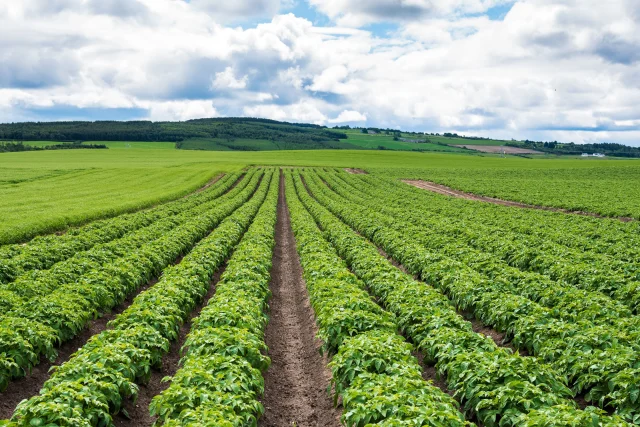Published on 6th June 2024
Local Insights
West: What the weather means for agronomic decisions

Gareth Bubb runs through the outstanding jobs on farm this June and July
Current situation
Crops have perked a lot in the last month after picking up fertiliser. It dried out enough to allow farmers to catch up with field work, but there has also been regular rain. That’s probably been helpful as the last thing we wanted at this stage was a drought with poor rooting. We also haven’t had much excessive heat so generally things are looking better.
Some wheat crops are a bit thin, but it’s not the end of the world as wheat can compensate. There’s lots of Septoria at our Callow Field Days site, but relatively little rust. Early brown rust has been a problem in some varieties, but I think growers have invested in T1s and are generally happy with the job it has done.
Flag leaf sprays are being applied currently and should be finished in most crops by the end of May.
Maize planting has started but I haven’t seen any crops emerged apart from where planted under plastic.
Gareth’s agronomy tips for June and July
1. Decide what the key target is for ear sprays
As with many agronomic decisions, being clear about what you are trying to achieve is crucial with ear sprays. If it to keep Fusarium out, then you need to be specific on your timing – early to mid-flowering.
But don’t forget about brown rust – there are lots of varieties on the Recommended List which are susceptible to brown rust and you will need to keep it controlled as it could rob yield and quality.
If it turns cooler around ear emergence and flowering, yellow rust could be an issue, although typically the threat drops off because of warmer weather. Damp weather will increase the risk of Fusarium and Septoria, hot weather favours brown rust.
Also think about the various modes of action and what they’re likely to do. SDHIs generally are stronger on brown rust and Septoria, strobilurins are also very useful against brown rust, while it is mainly the azoles prothioconazole and tebuconazole that cover Fusarium. But remember straight prothioconazole is not particularly good against brown rust and generally needs a partner.
Be aware of the latest application timings for key products. For example, you can use Aviator (bixafen + prothioconazole) later than Ascra (bixafen + fluopyram + prothioconazole).
What you have sprayed previously will need to be considered too. You have a maximum of two SDHI sprays and two strobilurin sprays. If you used a QiI product in fenpicoxamid earlier in the programme then that could open the opportunity to use Aviator at T3, for example, which will do a good job on foliar diseases and also prolong greening, which we know directly correlates to yield.
2. Protect later drilled crops of spring barley
With some later drilled crops of spring barley this year, there’s still a benefit of applying a fungicide spray around awns emerging. Keeping spring barley greener for longer is a bit more significant than in winter barley.
Foliar diseases such as Rhynchosporium and net blotch can also get out of hand quite quickly. Net blotch, in particular, has a short latent period and is inherently difficult to control.
If you can stop the crop from being stressed, it’s also less likely to express Ramularia. By controlling those other diseases you’re more likely to keep Ramularia out. While some products might claim activity against this disease, check what rate you need to apply to achieve that result – in some cases it is higher doses than usually used commercially.
Options from the Bayer range include Ascra, assuming you haven’t used it previously in the crop this season, and Siltra (bixafen + prothioconazole).
3. Don’t spray off oilseed rape too early
Oilseed rape crops haven been in the ground for nearly 12 months come harvest, but prolonging greening is just as important in rape as it is in wheat for yield. Spraying off too early will reduce yield, while also negatively impacting oil content and increasing red seeds, and therefore possible rejections.
So don’t be too keen to spray off to hit a target harvest date. Assessing when to spray is reasonably easy – if you can get into the crop. Find a representative part of the field, sample 20 pods and look for at least 66% of the seeds to have turned brown or black in at least 75% of the pods.
4. Choose OSR variety characteristics for intended drilling date
Pick oilseed rape varieties to suit your intended drilling window. If you’re planning to drill as early as possible after winter barley or early wheat harvest in late July or early August then you probably don’t want to a variety that is really quick with lots of autumn vigour. But you might want a variety with good light leaf spot and Phoma resistance.
If you’re looking at a more traditional oilseed rape drilling date, autumn vigour becomes crucial.
You could potentially use a Bayer Magic Trap to help pick when you should be drilling. It’s a yellow water trap with a camera attached that identifies the number of cabbage stem flea beetles that have entered the trap and sends the information to your phone through the Magic Scout app.
You could use it to help understand when peak migration is occurring to perhaps delay drilling until it has passed with a very vigorous variety.
Another potential use of the trap is to help understand if a crop isn’t emerging as expected whether it is cabbage stem flea beetle or another factor causing the problem. If you’re not picking up flea beetles in your trap, it could be slugs or residual herbicides that are causing the problem, for example.
5. Alternate blight products
With the potential for CAA and OSBPI-resistant blight strains to come across from Europe, where they were found last season, blight strategies will be in focus this season.
Following best practice advice such as alternating different modes of action and not blocking one product is a good idea, as is keeping intervals tight – no more than seven days between applications.
Nether active in Infinito (propamocarb + fluopicolide) use the modes of action impacted by the new blight strains, and it remains a very good option, offering good control of both foliar and tuber blight.
Most growers use it until later in the season because of its effect on tuber blight, but because of the blight population changes it also fits earlier in the season, helping with an alternation strategy.
In total, you can use up to four applications of Infinito during the programme at 1.6 L/ha.
6. Looking for grassweed activity in maize?
Weed control in maize is crucial as it’s a crop that doesn’t react well to competition. If you’re looking for the best grassweed activity combined with very good broadleaf weed control, then MaisTer (foramsulfuron + iodsulfuron) plus the adjuvant Mero is a good option.
It has quite limited residual activity so it needs applying when all the weeds have emerged, but before they are sheltered by the crop.
7. Visit our Bayer Field Day at Callow
The annual Bayer Field Day at Callow takes place on June 27. It will be a good event to learn more about new wheat varieties – we have about 50 varieties in total, plus see the performance of new fungicides, both our own and competitors. Given the weather currently it should be a good test.
We’ll also be talking about grassweed control, oilseed rape varieties and digital solutions – hope to see you there.
Acknowledgements
Aviator contains bixafen + prothioconazole. Ascra contains bixafen + prothioconazole + fluopyram. Siltra contains bixafen + prothioconazole. Infinito contains propamocarb + fluopicolide. MaisTer contains foramsulfuron + iodsulfuron. Aviator, Ascra, Siltra, Infinito and MaisTer are registered trademarks of Bayer. All other brand names used are Trademarks of other manufacturers in which proprietary rights may exist.
Use plant protection products safely. Always read the label and product information before use. Pay attention to the risk indications and follow the safety precautions on the label. For further information, including contact details, visit www.cropscience.bayer.co.uk or call 0808 1969522






